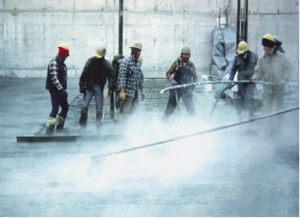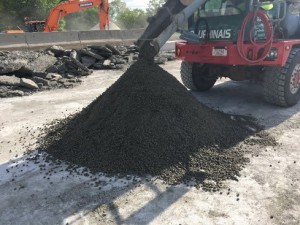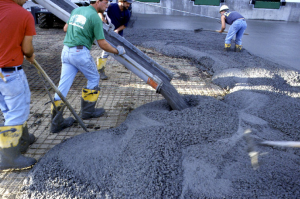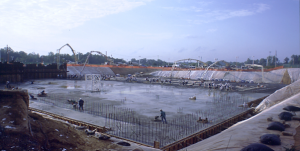3 Ways to Lower the CO2 Footprint of Buildings Using Concrete Admixtures
Concrete is used in virtually every build scenario, but not all concrete mixtures are created equal when it comes to the goal of construction sustainability. To further reduce the carbon footprint of buildings, consider the benefits of working with concrete admixtures.
Concrete admixtures can be used to reduce cement content, permit greater use of supplementary cementitious materials (SCMs), and even increase resistance to the environment, which can extend the lifespan of structures. Admixtures also have the potential to affect a reduction in the CO2 emissions associated with concrete production.
However, the impact of admixtures on sustainability can be complex, and involve many variables. The following three examples illustrate several ways that admixtures can contribute to a reduced CO2 footprint of concrete.
Example #1: Using superplasticizers in SCM mixes
Superplasticizers can be used to reduce water in a mix, thereby lowering the effective water-to-cement (w/c) ratio. Abrams’ law will permit the replacement of cement with supplementary cementitious materials, such as fly ash, while maintaining equivalent strengths. For example, a reference concrete with 350 kg/m3 (590 lb/yd3) of cement and 200 kg/m3 (337 lb/yd3) of water (0.57 w-to-cement ratio) can be treated with a superplasticizer. The water content of the concrete can be reduced to 160 kg/m3 (270 lb/yd3), for a 20% water reduction.
That water reduction allows 70 kg/m3 (118 lb/yd3) of cement to be removed and replaced with 84 kg/m3 (142 lb/yd3) of fly ash, creating a w/c ratio of 0.445. Some sand can also be added to the mix to maintain equivalent yield.
Even without factoring in the supply chain and resilience benefits resulting from easier placement and longer structure lifespan, the sum of these changes results in a concrete with 19% reduction in CO2 emissions. Given that reducing the amount of water required to produce building materials is also a key sustainability goal, this process represents a significant opportunity for builders to make meaningful improvements in this direction.
Example #2: Using superplasticizers and set accelerators in SCM mixes
Following similar methods as the one used above, we can also illustrate how combining the use of superplasticizers with set accelerators can even further reduce the CO2 emissions of concrete while partially overcoming the lower early strengths that have been associated with higher levels of cement replacement.
Using a similar dose of superplasticizer, we can reduce the water content of the mix to 169 kg/m3 (285 lb/yd3) and the cement content to 175 kg/m3 (295 lb/yd3). The cement removed is then replaced with 210 kg/m3 (354 lb/yd3) of fly ash, resulting in a w/c ratio of 0.44.
But here, a set accelerator is also introduced into the composition process to increase the early strength of the concrete mixture, noting that later-age strength typically is not an issue for fly ash mixes. The sum of these changes results in a concrete that delivers a very significant 34% reduction in CO2 emissions. If allowance for slower strength development were possible, thus allowing less accelerator use, the CO2 emissions would be further reduced.
Example #3: Using air entraining agents
Air entraining agents (AEAs) are surface active agents that function by stabilizing small air bubbles in the concrete. This provides for pressure relief when entrained water expands during freezing. For this reason, AEAs are required by building codes in many freeze-thaw susceptible regions in the world.
Air entraining agents are also useful in imparting workability to low-strength lean concretes. Due to the low paste volume in these concretes, aggregate-aggregate friction is a major obstacle to workability and slump development. When air entrainment is increased a few percentage points, the desired workability can be achieved with slight reductions in cement and water contents, resulting in modest (~3%) reductions in CO2 emissions. However, when factors such as improved durability (as a result of reduced bleeding and better compaction) are accounted for, the environmental impact over the concrete lifecycle can be considerable.
Conclusion
Creative use of concrete admixtures, alone or in combinations, can be used to make significant reductions in CO2 emissions associated with concrete production. Concrete is quite literally the foundation of most of our infrastructure. However, the process of concrete production has remained relatively unchanged for decades. There are new opportunities to reduce CO2 emissions by utilizing concrete admixtures with the above strategies. As architects, engineers, contractors and concrete producers it is critical that we collaborate and innovate to continue to lower the CO2 footprint of our built world.
Author’s note: Environmental assessment comparisons of the concrete were used to determine the CO2 emission reduction.
 About the Author: Diego Granell is a Director of Product Management and Marketing at GCP Applied Technologies in Cambridge, MA. He is globally responsible for development and introduction of new cement additive and concrete admixture products and systems with a strategic research focus on technologies reducing embodied carbon in concrete mix designs. Diego received an M.S and B.S. in Civil Engineering from the Technical University of Valencia, and an MBA from Dartmouth College’s Tuck School of Business. To learn more about concrete admixtures, visit the GCP Applied Technologies website, or contact Diego at Diego.Granell@gcpat.com.
About the Author: Diego Granell is a Director of Product Management and Marketing at GCP Applied Technologies in Cambridge, MA. He is globally responsible for development and introduction of new cement additive and concrete admixture products and systems with a strategic research focus on technologies reducing embodied carbon in concrete mix designs. Diego received an M.S and B.S. in Civil Engineering from the Technical University of Valencia, and an MBA from Dartmouth College’s Tuck School of Business. To learn more about concrete admixtures, visit the GCP Applied Technologies website, or contact Diego at Diego.Granell@gcpat.com.



